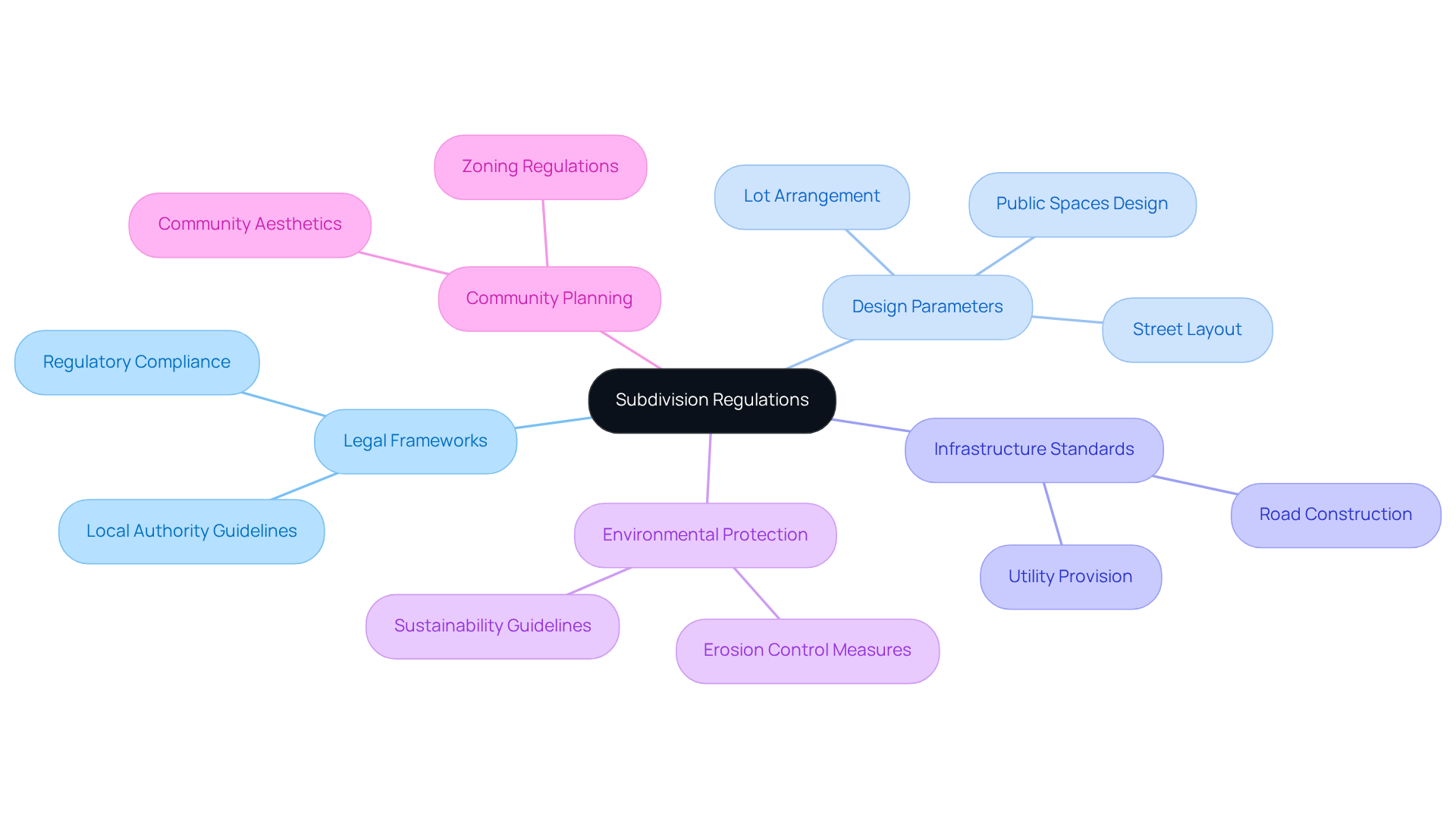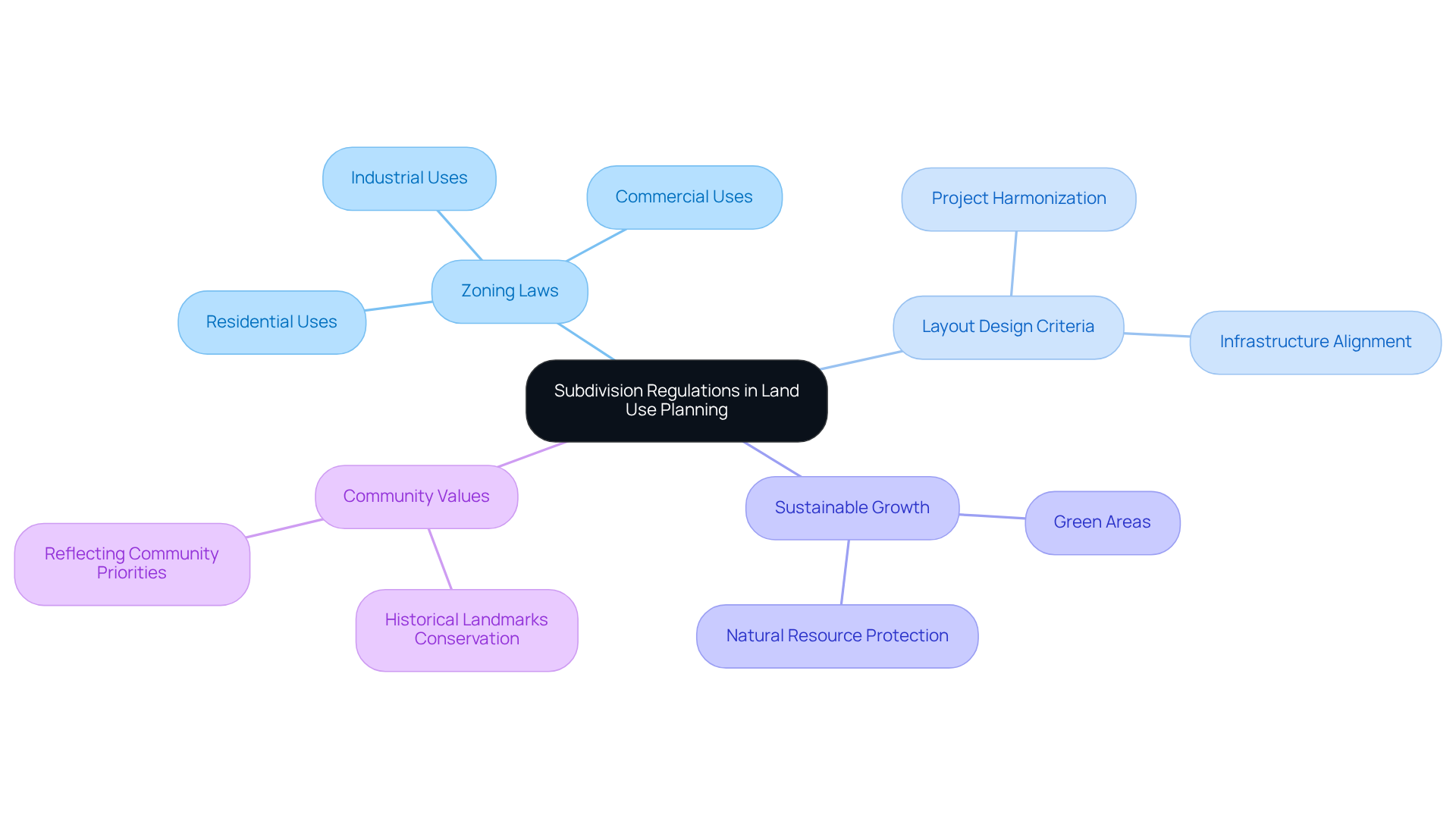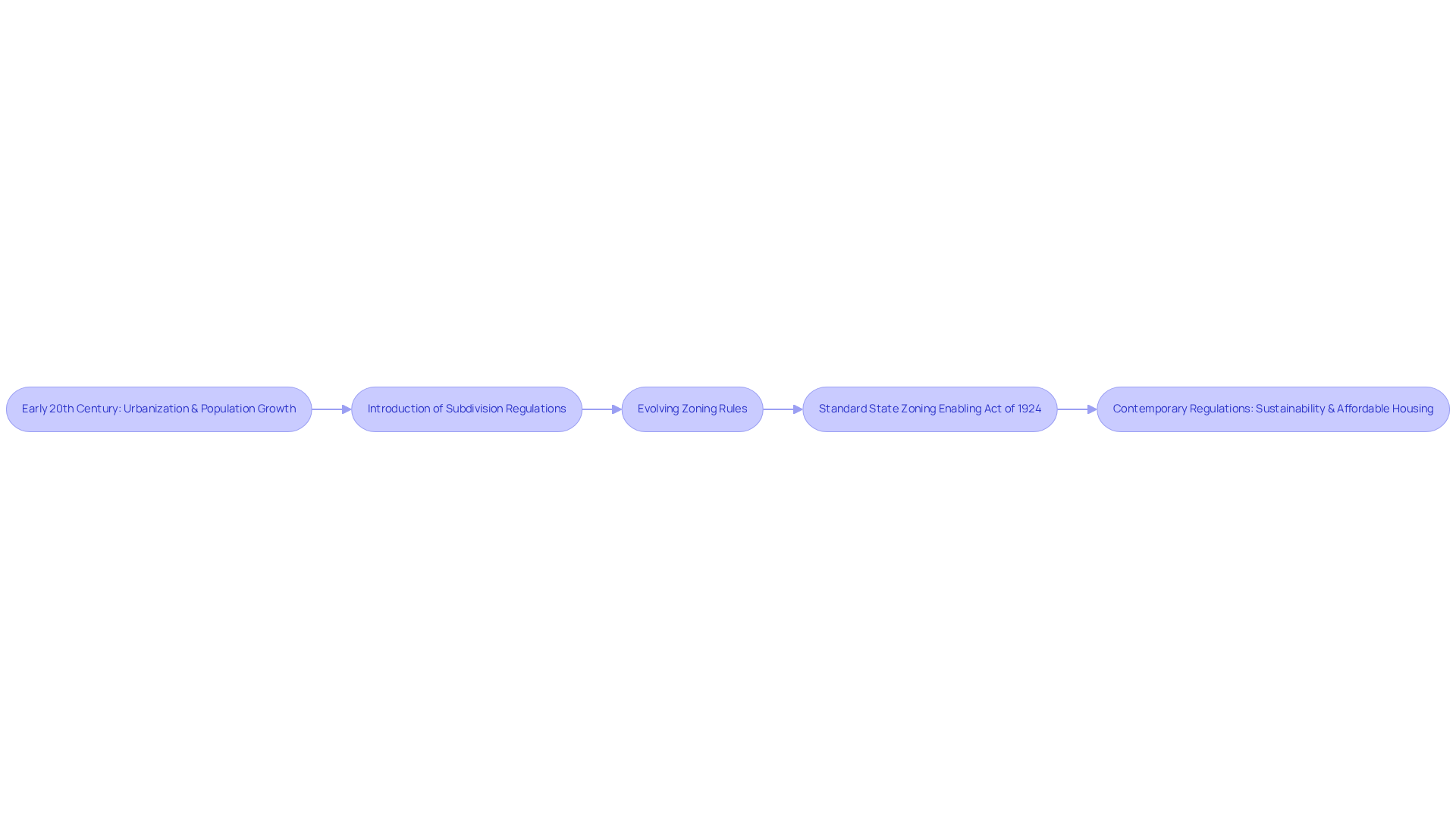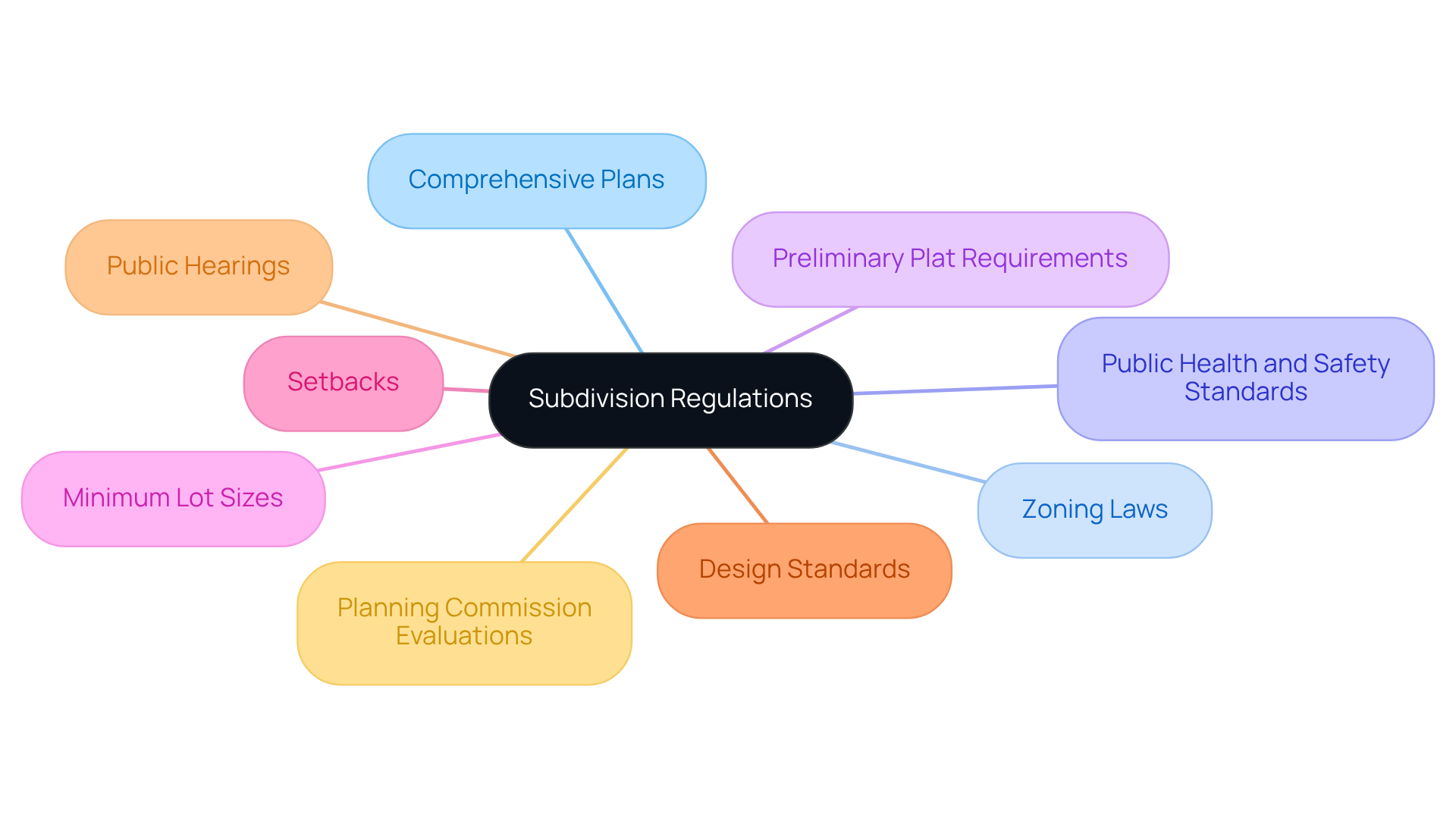Overview
The article delivers an authoritative overview of subdivision regulations, which are legal frameworks instituted by local authorities to govern the division of property for development. These regulations not only ensure compliance with infrastructure standards and community planning but also play a critical role in sustainable growth. Furthermore, the discussion encompasses the historical evolution, essential characteristics, and their integration with zoning laws. This illustrates how these regulations effectively protect natural resources and enhance community aesthetics, ultimately promoting a balanced approach to development.
Introduction
Understanding the intricate web of subdivision regulations is vital for anyone involved in property development or title research. These legal frameworks dictate how land can be divided and utilized, playing a significant role in shaping the aesthetics and functionality of communities. As urban areas continue to grow and evolve, the challenge remains: how can these regulations adapt to meet the demands of sustainable development while preserving the interests of current and future property owners? This article delves into a comprehensive overview of subdivision regulations, exploring their historical context, key characteristics, and their profound impact on land use planning and property titles.
Define Subdivision Regulations
The overview of subdivision regulations serves as legal frameworks established by local authorities to oversee the division of property into smaller parcels, primarily for development purposes. These guidelines delineate the parameters for land division, encompassing the design and arrangement of streets, lots, and public spaces. They ensure that subdivisions adhere to the established standards for infrastructure, environmental protection, and community planning as detailed in the overview of subdivision regulations.
Furthermore, by providing a structured framework for developers, these regulations serve as an overview of subdivision regulations that play a crucial role in maintaining the quality and safety of both residential and commercial projects. Ultimately, this adherence positively influences and enhances community aesthetics.

Contextualize Subdivision Regulations in Land Use Planning
An overview of subdivision regulations is pivotal in land use planning, directing the development and utilization of land within a community. These guidelines serve as an overview of subdivision regulations that are often integrated with zoning laws, dictating the types of activities permitted in specific areas, such as residential, commercial, or industrial uses. By establishing criteria for layout design, these guidelines ensure that new projects harmonize with existing neighborhoods and infrastructure. This alignment is essential for , protecting natural resources, and enhancing the overall quality of life for residents. For instance, guidelines may require the inclusion of green areas or the conservation of historical landmarks, reflecting community values and priorities.

Trace the Historical Development of Subdivision Regulations
The origins of zoning rules can be traced back to the early 20th century, a period marked by rapid urbanization and population growth that necessitated structured property use. Initially, these guidelines were designed to provide an overview of subdivision regulations, facilitating property sales by offering a clear framework for dividing larger parcels into smaller lots. Over time, as cities expanded and land use complexities increased, zoning rules evolved to address pressing concerns such as infrastructure development, environmental protection, and community aesthetics. Notably, the Standard State Zoning Enabling Act of 1924 laid the groundwork for modern land use regulations, underscoring the importance of planning in urban development. Today, these regulations continue to evolve, responding to contemporary challenges such as sustainability and the need for affordable housing.

Identify Key Characteristics of Subdivision Regulations
The essential features of development guidelines are pivotal, encompassing stipulations for the presentation of comprehensive plans, conformity to zoning laws, and adherence to public health and safety standards. Developers are typically required to provide a preliminary plat that outlines the proposed layout of streets, lots, and public spaces, along with plans for utilities and drainage systems. Furthermore, guidelines frequently specify minimum lot sizes, setbacks, and design standards to ensure that projects are both functional and visually appealing.
Public hearings and evaluations by planning commissions are also integral to the subdivision approval procedure, as they provide an overview of subdivision regulations while facilitating community input and ensuring that projects align with local objectives. These characteristics not only promote but also protect the interests of current and future property owners.

Conclusion
Subdivision regulations establish a crucial framework for property division, ensuring that development occurs in a structured and compliant manner. These regulations govern not only the physical division of land but also significantly influence community aesthetics, infrastructure, and overall quality of life. By adhering to these guidelines, developers promote sustainable growth and safeguard property values, underscoring the essential role of subdivision regulations in real estate and urban planning.
Key insights from the article illuminate the historical evolution of subdivision regulations, which originated in the early 20th century as a response to urbanization. Over the years, these regulations have adapted to contemporary challenges, integrating with zoning laws and placing a strong emphasis on environmental protection and community values. Characteristics of subdivision regulations, such as minimum lot sizes and public input through hearings, further ensure that development aligns with local objectives and fosters orderly growth.
Ultimately, grasping subdivision regulations is vital for anyone engaged in title research or real estate development. As these regulations continue to evolve, remaining informed about their implications empowers stakeholders to make informed decisions that enhance community well-being. Engaging with these guidelines not only promotes responsible development but also reinforces the significance of planning in cultivating vibrant, sustainable communities.
Frequently Asked Questions
What are subdivision regulations?
Subdivision regulations are legal frameworks established by local authorities to oversee the division of property into smaller parcels for development purposes.
What do subdivision regulations cover?
These regulations cover the design and arrangement of streets, lots, and public spaces, ensuring that subdivisions adhere to established standards for infrastructure, environmental protection, and community planning.
Why are subdivision regulations important for developers?
They provide a structured framework that helps developers maintain quality and safety in both residential and commercial projects.
How do subdivision regulations affect property values?
Adherence to subdivision regulations positively influences property values and enhances community aesthetics.




